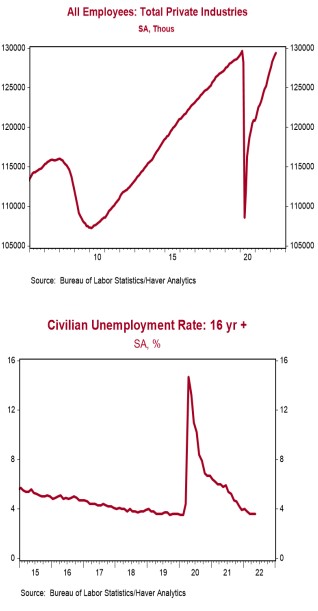- Nonfarm payrolls increased 390,000 in May, beating the consensus expected 318,000. Payroll gains for March and April were revised down by a total of 22,000, bringing the net gain, including revisions, to 368,000.
- Private sector payrolls rose 333,000 in May but were revised down 40,000 in prior months. The largest increases in May were for leisure & hospitality (+84,000), professional & business services (+75,000, including temps), and education & health services (+74,000). The largest decline was in retail
(-61,000). Manufacturing increased 18,000 while government rose 57,000. - The unemployment rate remained at 3.6% in May.
- Average hourly earnings – cash earnings, excluding irregular bonuses/commissions and fringe benefits – rose 0.3% in May and are up 5.2% versus a year ago. Aggregate hours increased 0.3% in May and are up 4.2% from a year ago.
Implications:
More improvement in the job market and no recession in sight, at least not yet. Nonfarm payrolls increased 390,000 in May, beating the consensus expected 318,000. Meanwhile, civilian employment, an alternative measure of jobs that includes small-business start-ups, increased 321,000. The unemployment rate remained at 3.6%, in spite of the healthy increase in jobs, because of a 330,000 increase in the labor force. But the increase in the labor force is good news and the number of people who are either working or looking for work should continue to increase in the year ahead. The details of the jobs report were also solid. Total hours worked rose 0.3% in May, are up 4.2% from a year ago, and are up 0.4% versus pre-COVID. Average hourly earnings didn't rise as much as the 0.4% the consensus expected, but were close, rising 0.3% in May and are up 5.2% from a year ago. If there is any glaring problem for workers, it's that wages are not keeping pace with the inflation. We estimate that consumer prices rose 0.7% in May and are up 8.5% versus a year ago. So, workers are earning more per hour but those earnings are lagging inflation by a substantial margin. In addition, it's important to recognize that the labor market is still not fully healed from COVID and related lockdowns. Nonfarm payrolls are 822,000 short of where they were in February 2020, although we should be able to finally exceed the pre-COVID peak by late Summer. In other recent news on the job market, new claims for unemployment insurance declined 11,000 last week to 200,000. Continuing claims fell 34,000 to 1.309 million. Look for further job gains in June. Where does all this leave the Federal Reserve? Still in need to tighten monetary policy to wrestle inflation under control. Ultimately that entails increasing the risk of a recession, but that recession is very unlikely to materialize this year or early in 2023.





